University Marketing Research: Measurements and Rating Scales
VerifiedAdded on 2023/06/10
|6
|915
|277
Homework Assignment
AI Summary
This homework assignment addresses key concepts in marketing research, specifically focusing on research measurements and rating scales. The solution provides answers to questions related to defining research problems, selecting appropriate sampling techniques (stratified random, cluster, systematic, simple random, convenience, self-selection, snowball, and purpose sampling), and understanding different measurement scales. The assignment also covers the application of various rating scales, including semantic differential, graphic rating, side-by-side matrix, and Likert scales, in the context of customer service surveys. The solution demonstrates an understanding of how to formulate survey questions and select the correct rating scale for specific research objectives. The references provided offer additional resources for further study on these topics.
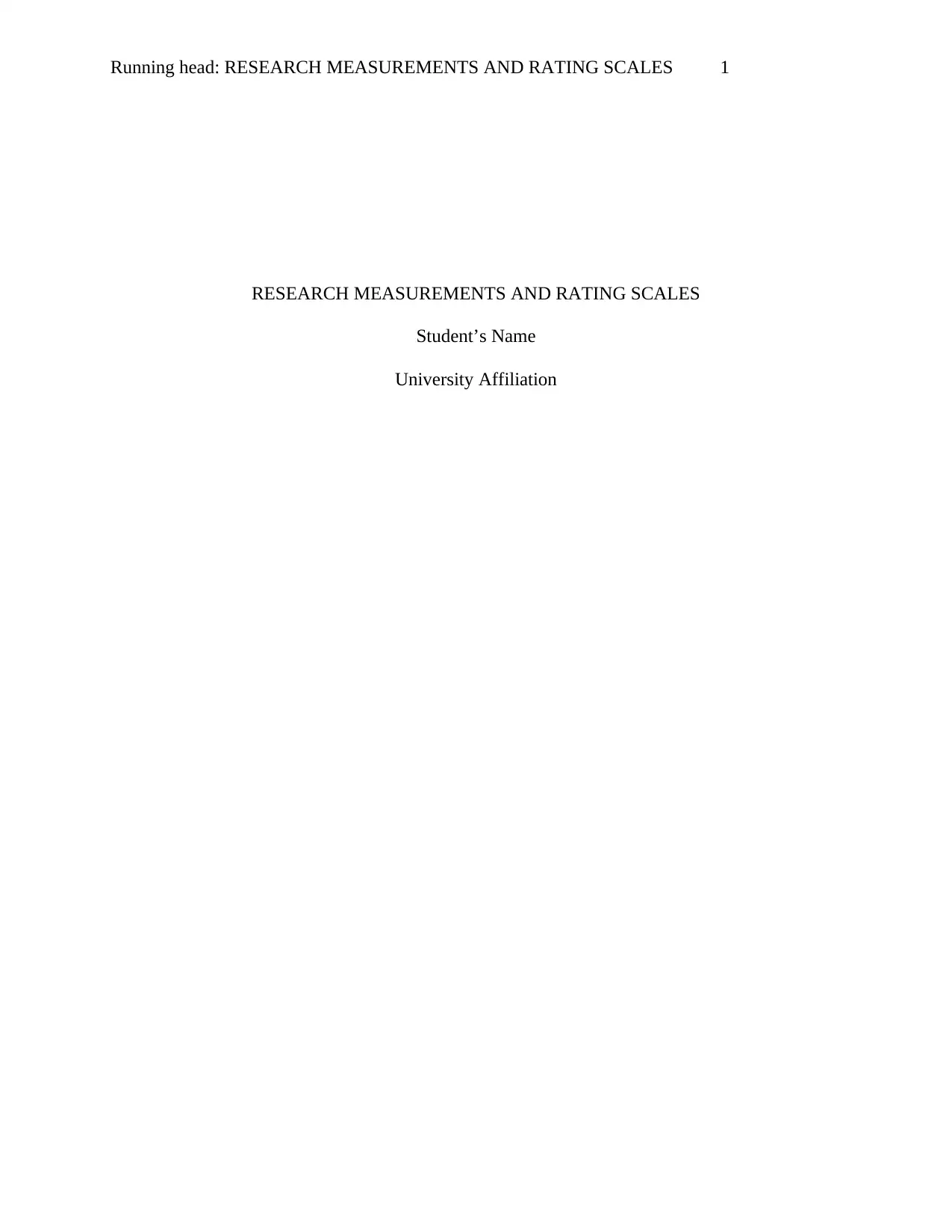
Running head: RESEARCH MEASUREMENTS AND RATING SCALES 1
RESEARCH MEASUREMENTS AND RATING SCALES
Student’s Name
University Affiliation
RESEARCH MEASUREMENTS AND RATING SCALES
Student’s Name
University Affiliation
Paraphrase This Document
Need a fresh take? Get an instant paraphrase of this document with our AI Paraphraser
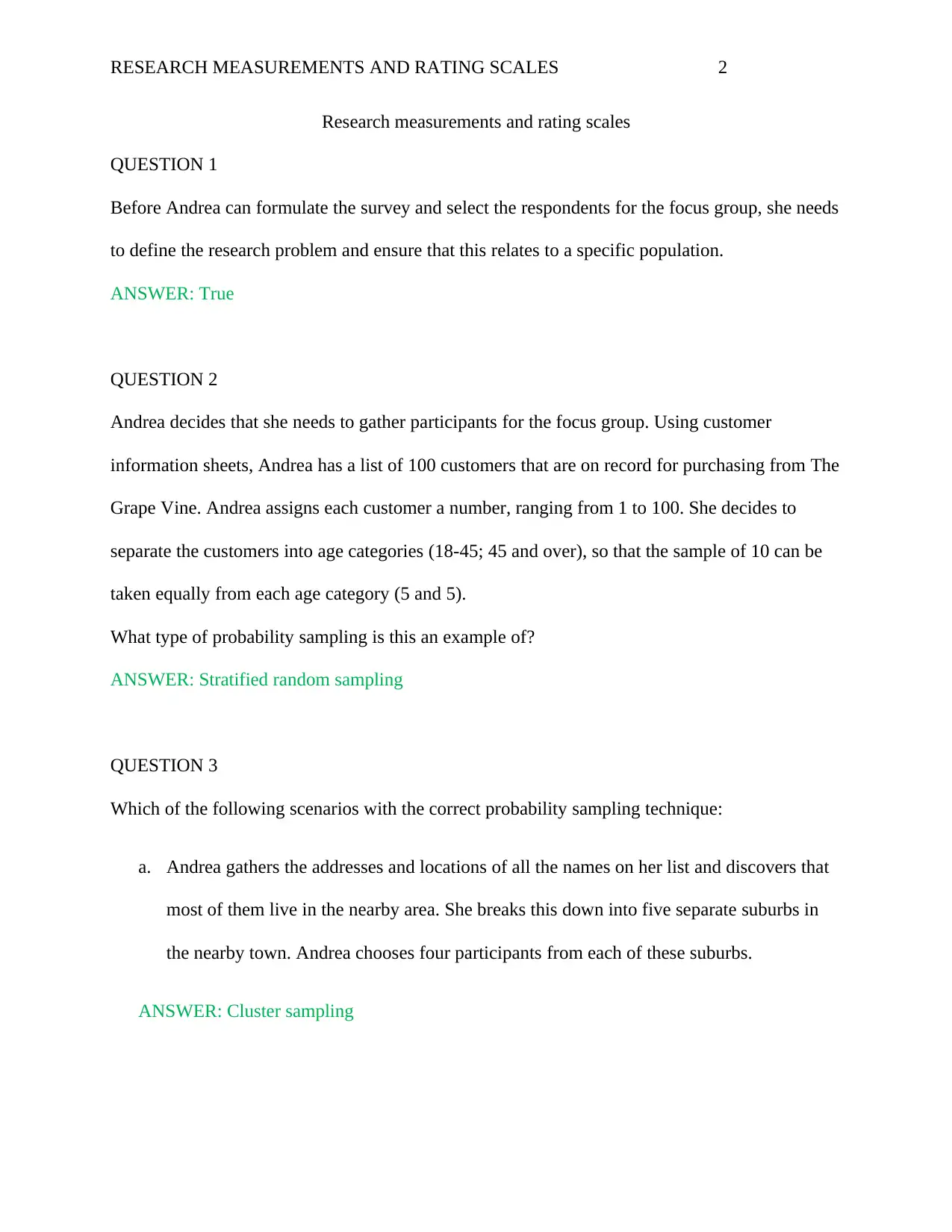
RESEARCH MEASUREMENTS AND RATING SCALES 2
Research measurements and rating scales
QUESTION 1
Before Andrea can formulate the survey and select the respondents for the focus group, she needs
to define the research problem and ensure that this relates to a specific population.
ANSWER: True
QUESTION 2
Andrea decides that she needs to gather participants for the focus group. Using customer
information sheets, Andrea has a list of 100 customers that are on record for purchasing from The
Grape Vine. Andrea assigns each customer a number, ranging from 1 to 100. She decides to
separate the customers into age categories (18-45; 45 and over), so that the sample of 10 can be
taken equally from each age category (5 and 5).
What type of probability sampling is this an example of?
ANSWER: Stratified random sampling
QUESTION 3
Which of the following scenarios with the correct probability sampling technique:
a. Andrea gathers the addresses and locations of all the names on her list and discovers that
most of them live in the nearby area. She breaks this down into five separate suburbs in
the nearby town. Andrea chooses four participants from each of these suburbs.
ANSWER: Cluster sampling
Research measurements and rating scales
QUESTION 1
Before Andrea can formulate the survey and select the respondents for the focus group, she needs
to define the research problem and ensure that this relates to a specific population.
ANSWER: True
QUESTION 2
Andrea decides that she needs to gather participants for the focus group. Using customer
information sheets, Andrea has a list of 100 customers that are on record for purchasing from The
Grape Vine. Andrea assigns each customer a number, ranging from 1 to 100. She decides to
separate the customers into age categories (18-45; 45 and over), so that the sample of 10 can be
taken equally from each age category (5 and 5).
What type of probability sampling is this an example of?
ANSWER: Stratified random sampling
QUESTION 3
Which of the following scenarios with the correct probability sampling technique:
a. Andrea gathers the addresses and locations of all the names on her list and discovers that
most of them live in the nearby area. She breaks this down into five separate suburbs in
the nearby town. Andrea chooses four participants from each of these suburbs.
ANSWER: Cluster sampling
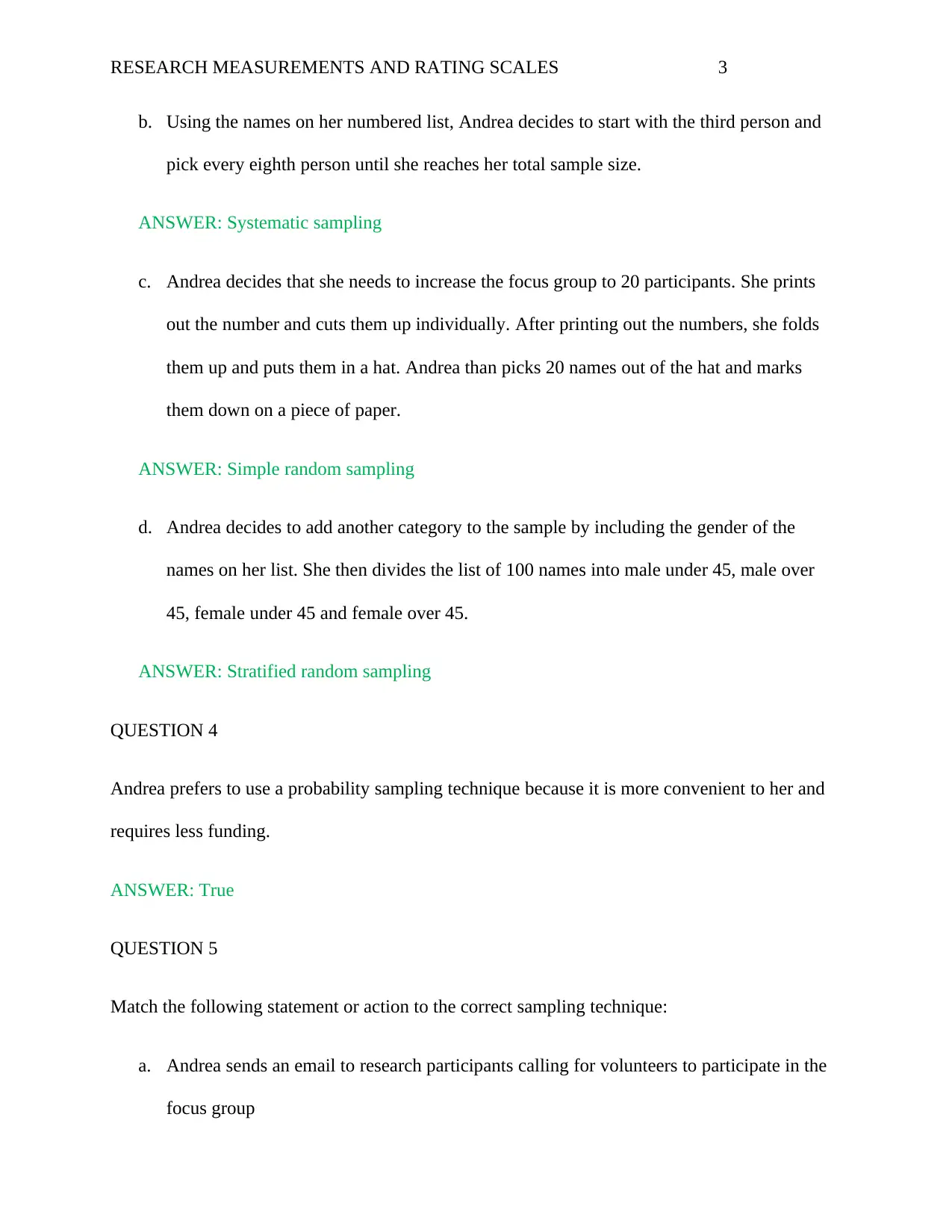
RESEARCH MEASUREMENTS AND RATING SCALES 3
b. Using the names on her numbered list, Andrea decides to start with the third person and
pick every eighth person until she reaches her total sample size.
ANSWER: Systematic sampling
c. Andrea decides that she needs to increase the focus group to 20 participants. She prints
out the number and cuts them up individually. After printing out the numbers, she folds
them up and puts them in a hat. Andrea than picks 20 names out of the hat and marks
them down on a piece of paper.
ANSWER: Simple random sampling
d. Andrea decides to add another category to the sample by including the gender of the
names on her list. She then divides the list of 100 names into male under 45, male over
45, female under 45 and female over 45.
ANSWER: Stratified random sampling
QUESTION 4
Andrea prefers to use a probability sampling technique because it is more convenient to her and
requires less funding.
ANSWER: True
QUESTION 5
Match the following statement or action to the correct sampling technique:
a. Andrea sends an email to research participants calling for volunteers to participate in the
focus group
b. Using the names on her numbered list, Andrea decides to start with the third person and
pick every eighth person until she reaches her total sample size.
ANSWER: Systematic sampling
c. Andrea decides that she needs to increase the focus group to 20 participants. She prints
out the number and cuts them up individually. After printing out the numbers, she folds
them up and puts them in a hat. Andrea than picks 20 names out of the hat and marks
them down on a piece of paper.
ANSWER: Simple random sampling
d. Andrea decides to add another category to the sample by including the gender of the
names on her list. She then divides the list of 100 names into male under 45, male over
45, female under 45 and female over 45.
ANSWER: Stratified random sampling
QUESTION 4
Andrea prefers to use a probability sampling technique because it is more convenient to her and
requires less funding.
ANSWER: True
QUESTION 5
Match the following statement or action to the correct sampling technique:
a. Andrea sends an email to research participants calling for volunteers to participate in the
focus group
⊘ This is a preview!⊘
Do you want full access?
Subscribe today to unlock all pages.

Trusted by 1+ million students worldwide
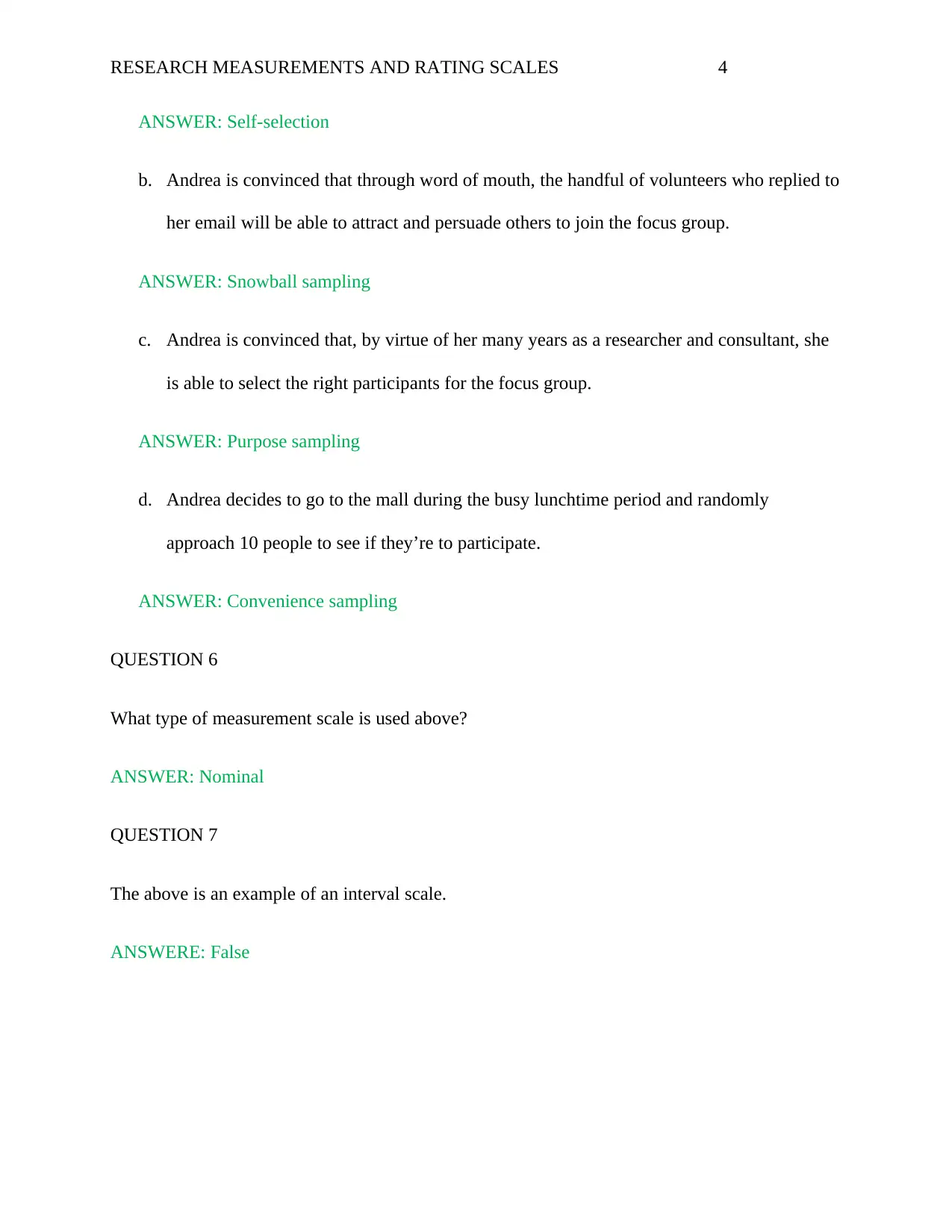
RESEARCH MEASUREMENTS AND RATING SCALES 4
ANSWER: Self-selection
b. Andrea is convinced that through word of mouth, the handful of volunteers who replied to
her email will be able to attract and persuade others to join the focus group.
ANSWER: Snowball sampling
c. Andrea is convinced that, by virtue of her many years as a researcher and consultant, she
is able to select the right participants for the focus group.
ANSWER: Purpose sampling
d. Andrea decides to go to the mall during the busy lunchtime period and randomly
approach 10 people to see if they’re to participate.
ANSWER: Convenience sampling
QUESTION 6
What type of measurement scale is used above?
ANSWER: Nominal
QUESTION 7
The above is an example of an interval scale.
ANSWERE: False
ANSWER: Self-selection
b. Andrea is convinced that through word of mouth, the handful of volunteers who replied to
her email will be able to attract and persuade others to join the focus group.
ANSWER: Snowball sampling
c. Andrea is convinced that, by virtue of her many years as a researcher and consultant, she
is able to select the right participants for the focus group.
ANSWER: Purpose sampling
d. Andrea decides to go to the mall during the busy lunchtime period and randomly
approach 10 people to see if they’re to participate.
ANSWER: Convenience sampling
QUESTION 6
What type of measurement scale is used above?
ANSWER: Nominal
QUESTION 7
The above is an example of an interval scale.
ANSWERE: False
Paraphrase This Document
Need a fresh take? Get an instant paraphrase of this document with our AI Paraphraser
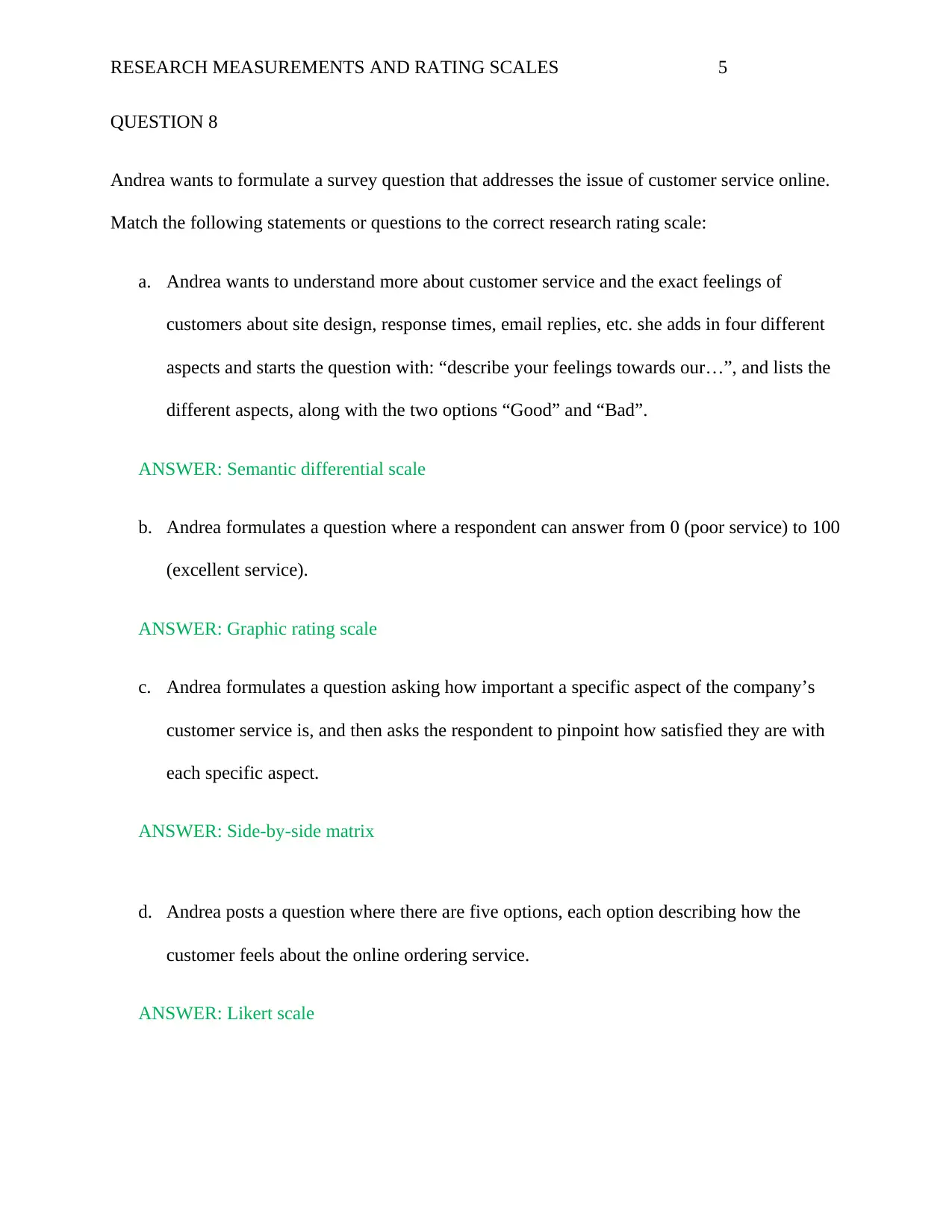
RESEARCH MEASUREMENTS AND RATING SCALES 5
QUESTION 8
Andrea wants to formulate a survey question that addresses the issue of customer service online.
Match the following statements or questions to the correct research rating scale:
a. Andrea wants to understand more about customer service and the exact feelings of
customers about site design, response times, email replies, etc. she adds in four different
aspects and starts the question with: “describe your feelings towards our…”, and lists the
different aspects, along with the two options “Good” and “Bad”.
ANSWER: Semantic differential scale
b. Andrea formulates a question where a respondent can answer from 0 (poor service) to 100
(excellent service).
ANSWER: Graphic rating scale
c. Andrea formulates a question asking how important a specific aspect of the company’s
customer service is, and then asks the respondent to pinpoint how satisfied they are with
each specific aspect.
ANSWER: Side-by-side matrix
d. Andrea posts a question where there are five options, each option describing how the
customer feels about the online ordering service.
ANSWER: Likert scale
QUESTION 8
Andrea wants to formulate a survey question that addresses the issue of customer service online.
Match the following statements or questions to the correct research rating scale:
a. Andrea wants to understand more about customer service and the exact feelings of
customers about site design, response times, email replies, etc. she adds in four different
aspects and starts the question with: “describe your feelings towards our…”, and lists the
different aspects, along with the two options “Good” and “Bad”.
ANSWER: Semantic differential scale
b. Andrea formulates a question where a respondent can answer from 0 (poor service) to 100
(excellent service).
ANSWER: Graphic rating scale
c. Andrea formulates a question asking how important a specific aspect of the company’s
customer service is, and then asks the respondent to pinpoint how satisfied they are with
each specific aspect.
ANSWER: Side-by-side matrix
d. Andrea posts a question where there are five options, each option describing how the
customer feels about the online ordering service.
ANSWER: Likert scale
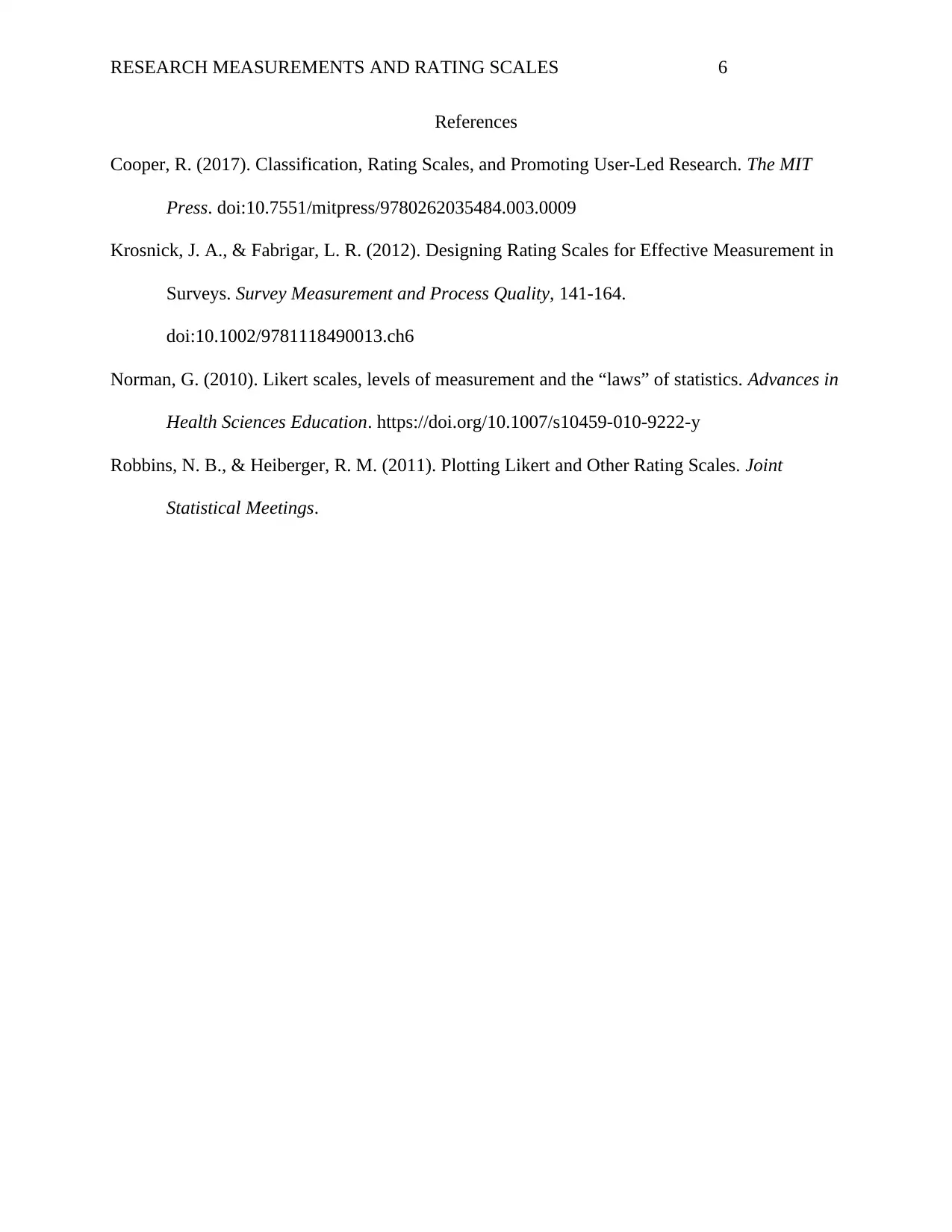
RESEARCH MEASUREMENTS AND RATING SCALES 6
References
Cooper, R. (2017). Classification, Rating Scales, and Promoting User-Led Research. The MIT
Press. doi:10.7551/mitpress/9780262035484.003.0009
Krosnick, J. A., & Fabrigar, L. R. (2012). Designing Rating Scales for Effective Measurement in
Surveys. Survey Measurement and Process Quality, 141-164.
doi:10.1002/9781118490013.ch6
Norman, G. (2010). Likert scales, levels of measurement and the “laws” of statistics. Advances in
Health Sciences Education. https://doi.org/10.1007/s10459-010-9222-y
Robbins, N. B., & Heiberger, R. M. (2011). Plotting Likert and Other Rating Scales. Joint
Statistical Meetings.
References
Cooper, R. (2017). Classification, Rating Scales, and Promoting User-Led Research. The MIT
Press. doi:10.7551/mitpress/9780262035484.003.0009
Krosnick, J. A., & Fabrigar, L. R. (2012). Designing Rating Scales for Effective Measurement in
Surveys. Survey Measurement and Process Quality, 141-164.
doi:10.1002/9781118490013.ch6
Norman, G. (2010). Likert scales, levels of measurement and the “laws” of statistics. Advances in
Health Sciences Education. https://doi.org/10.1007/s10459-010-9222-y
Robbins, N. B., & Heiberger, R. M. (2011). Plotting Likert and Other Rating Scales. Joint
Statistical Meetings.
⊘ This is a preview!⊘
Do you want full access?
Subscribe today to unlock all pages.

Trusted by 1+ million students worldwide
1 out of 6
Your All-in-One AI-Powered Toolkit for Academic Success.
+13062052269
info@desklib.com
Available 24*7 on WhatsApp / Email
![[object Object]](/_next/static/media/star-bottom.7253800d.svg)
Unlock your academic potential
Copyright © 2020–2025 A2Z Services. All Rights Reserved. Developed and managed by ZUCOL.
